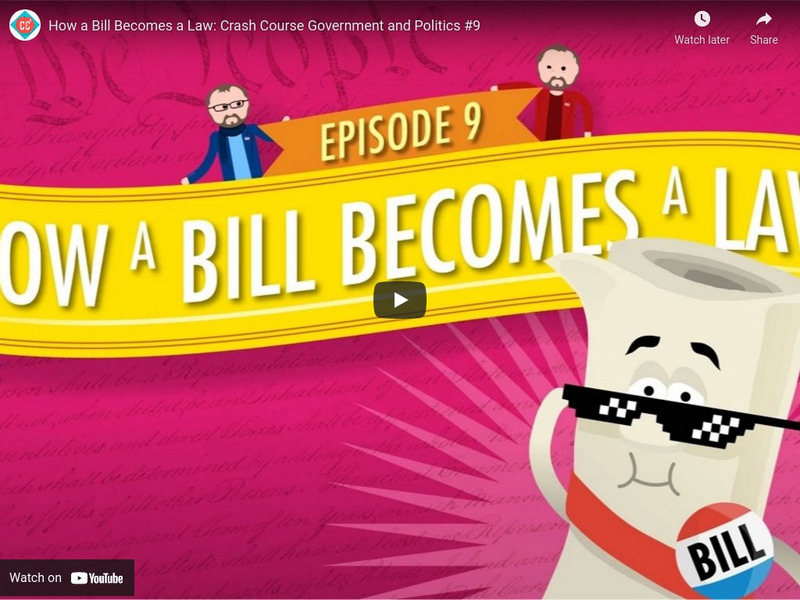Other
The Center on Congress: How a Bill Becomes Law
Video looking at how an idea for a law eventually becomes an official law. [0:56]
Library of Congress
Loc: congress.gov: The Legislative Process
A collection of short videos that explain the different stages of the legislative process, including the introduction and referral of bills, debate by a committee, placement on a calendar for discussion about whether it will be sent to...
Library of Congress
Loc: congress.gov: The Legislative Process: Introduction and Referral of Bills
Bills can be suggested in a myriad of ways, but only members of each chamber can officially introduce legislation. In the House, a bill is introduced when it is dropped in a hopper, and in the Senate, a bill is submitted to clerks on the...
Library of Congress
Loc: congress.gov: The Legislative Process: Committee Consideration
Congress receives many bill referrals over the course of a term. How do they decide which bills will make it to the house floor? Committees hold this power and play an important role in deciding which bills get debated by Congress. Watch...
Library of Congress
Loc: congress.gov: The Legislative Process: House Floor
Learn about the procedures followed by the House of Representatives when debating a bill. Watch the video or read the transcript which describes the committees and a variety of procedures the House follows. A chart of the legislative...
Library of Congress
Loc: congress.gov: The Legislative Process: Executive Business in the Senate
The Senate has two unique responsibilities: the power to make treaties and the power to confirm presidential nominees. View this video to understand how these powers fit into the legislative process. A transcript is provided, along with...
Library of Congress
Loc: congress.gov: The Legislative Process: Resolving Differences
A bill must be agreed upon by both chambers before being submitted to the President. This brief video describes how the House and Senate resolve their differences. A transcript is provided, along with a chart of the entire legislative...
Backstory Radio
Back Story Radio: Stuck: A History of Gridlock
BackStory episode examines the topic of legislative standoffs in Congress by looking at the history of Congressional gridlock and evaluating the outcome. Audio and transcript are provided.
Annenberg Foundation
Annenberg Classroom: The Legislative Process: How a Bill Becomes a Federal Law
Video [19:00] in which Senator Diane Feinstein and Representative Pete Sessions discuss with a group of high school students the legislative process. An informative explanation with visuals and anecdotal information to support...
Khan Academy
Khan Academy: How a Bill Becomes a Law
This video lesson from Khan Academy discusses how a bill becomes a law. This lesson is intended for students taking high school or college level American Government and Civics courses, including the AP Government course.
PBS
Pbs Learning Media: Crash Course Government and Politics: How a Bill Becomes a Law
The process of how a bill becomes a law can be pretty complex. As if just getting through committee isn't difficult enough, bills have to navigate a series of amendments and votes in both houses, potentially more committees, further...
Center For Civic Education
60 Second Civics: How Congress Functions: Pt. 16: How a Bill Becomes a Law
The lengthy process a bill must go through before it becomes a law is explained.
Center For Civic Education
60 Second Civics: How Congress Functions: Pt. 18: Mark Up Sessions
Mark-up sessions are committee meetings that happen at a later stage in the process a bill goes through before a final vote in the Senate or the House.
Center For Civic Education
60 Second Civics: How Congress Functions: Pt. 19: Conference Committees
A conference committee is comprised of members from both chambers of Congress. It tries to resolve differences between the House and the Senate over the content of a bill. It issues a conference report to both chambers for a vote.
Center For Civic Education
60 Second Civics: How Congress Functions: Pt. 20: Vetoes and Overrides
Even when a bill is passed by Congress, it still must be signed by the President, who may decide to veto it. If this happens, Congress can also override that veto through a new vote in both chambers.
Center For Civic Education
60 Second Civics: How Congress Functions: Pt. 21: Majority Support
At every stage in the process of becoming a law, a bill is scrutinized and must have majority support for it in order to be moved along.
Crash Course
Crash Course Government and Politics #9: How a Bill Becomes a Law
Crash Course video teaches about the many steps involved in a bill becomimg a law. [7:00]
Library of Congress
Loc: congress.gov: The Legislative Process: Calendars and Scheduling
Once a committee reports a bill, it is placed on the calendar in the Senate and House. Watch this video to see the procedures for placing a bill on the calendar and who decides the order the bills will be debated. A chart of the...
Library of Congress
Loc: congress.gov: The Legislative Process: Presidential Actions
This brief video describes the presidential veto power as part of the legislative process. A transcript is provided, along with a chart of the entire legislative process. [1:59]











